Sony (China) Case Study: HR Evolution, Role, and Impact on Learning
VerifiedAdded on 2023/04/26
|7
|1153
|492
Case Study
AI Summary
This case study explores the evolution of the Human Resource (HR) function at Sony (China) Ltd, highlighting its transformation into a learning organization. Starting with Ms. Alicia Mei overseeing personnel in 1978, the HR function evolved significantly, focusing on talent retention and development. The HR division played a crucial role in recruitment, employee relations, counseling, and strategic planning. A key contribution was the introduction of team-based projects through the China Europe International Business School (CEIBS) program, fostering teamwork and talent identification within Sony. The study suggests observation and experiential methods for evaluating training program effectiveness. Ultimately, the evolution of HR at Sony (China) led to improved talent retention, teamwork, and career opportunities for employees. Desklib offers solved assignments and past papers for students.
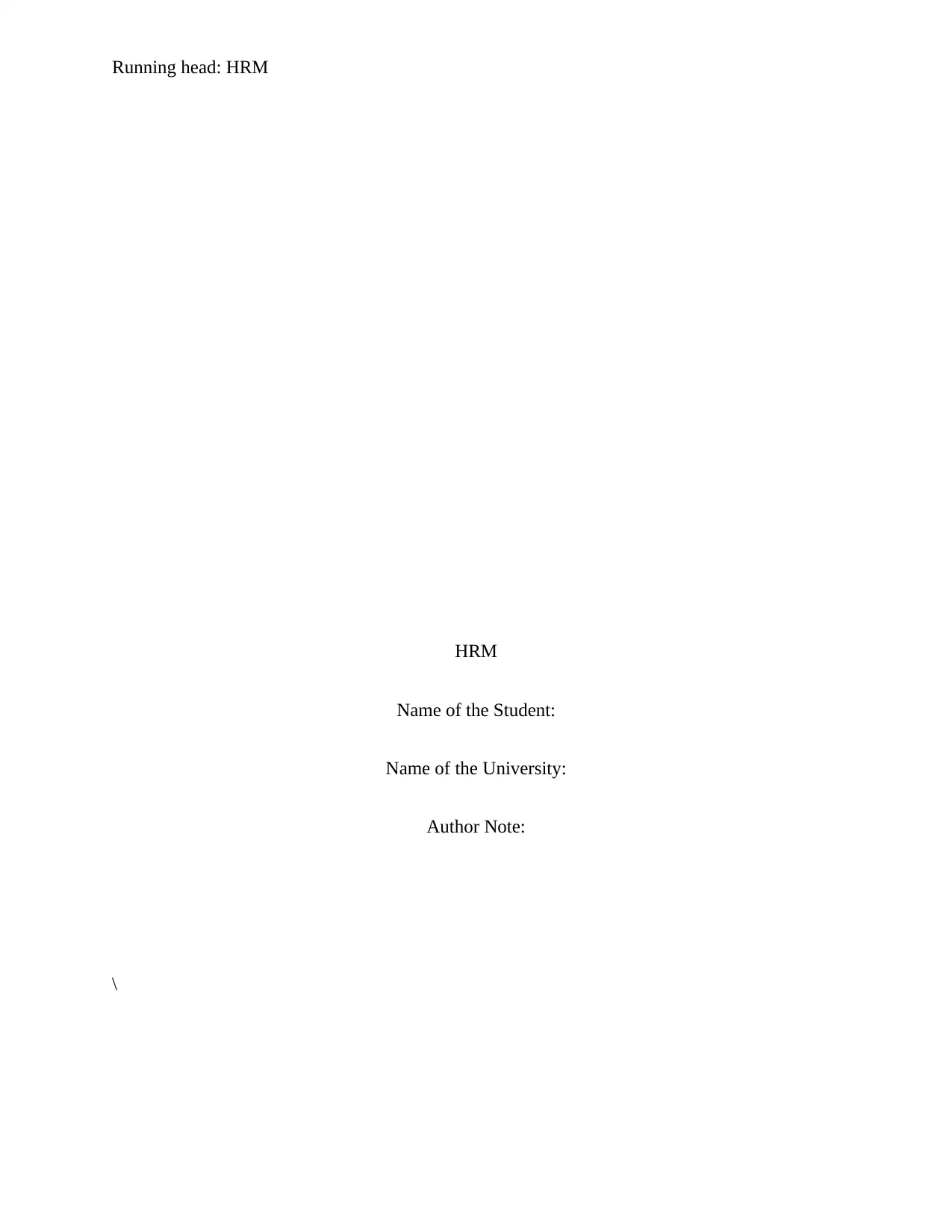
Running head: HRM
HRM
Name of the Student:
Name of the University:
Author Note:
\
HRM
Name of the Student:
Name of the University:
Author Note:
\
Paraphrase This Document
Need a fresh take? Get an instant paraphrase of this document with our AI Paraphraser
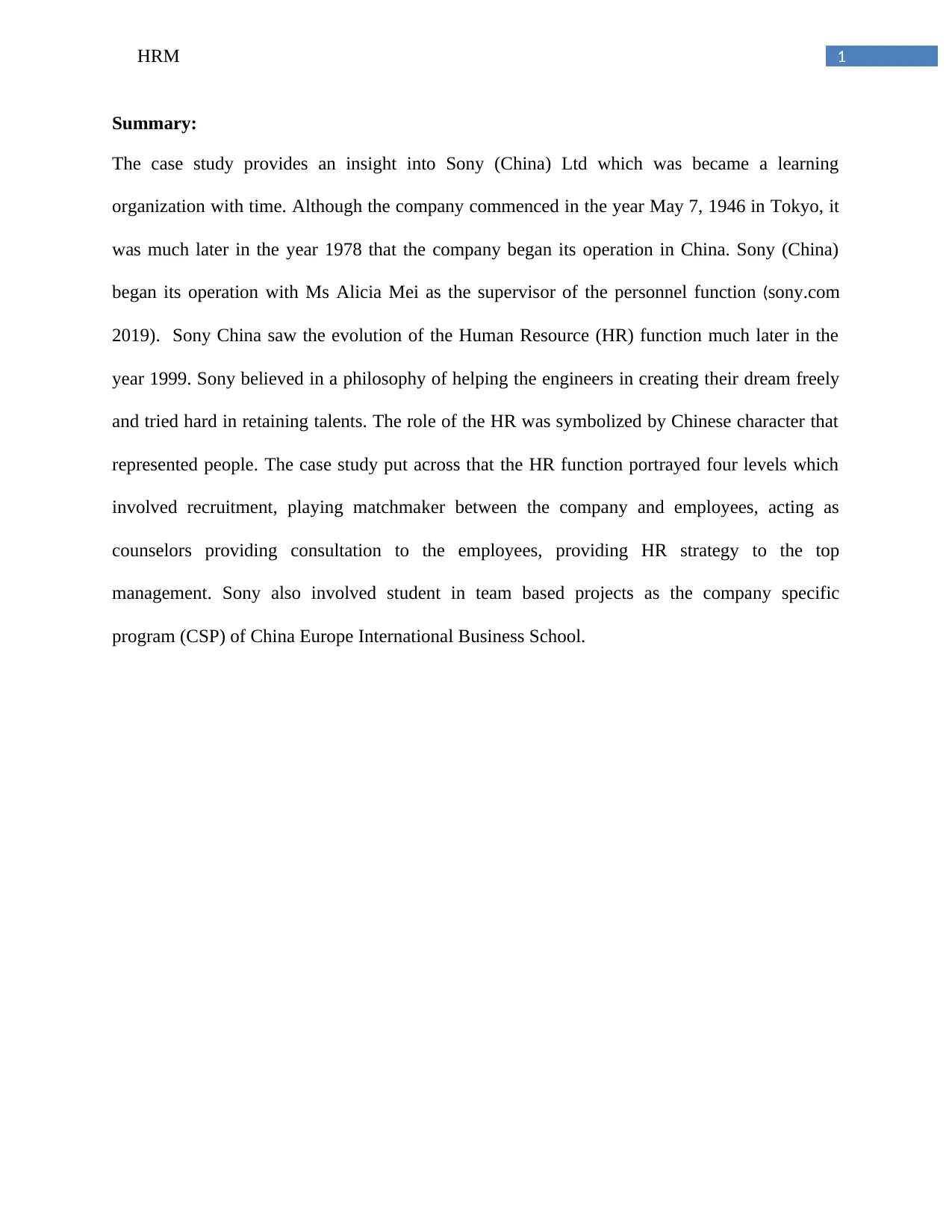
1HRM
Summary:
The case study provides an insight into Sony (China) Ltd which was became a learning
organization with time. Although the company commenced in the year May 7, 1946 in Tokyo, it
was much later in the year 1978 that the company began its operation in China. Sony (China)
began its operation with Ms Alicia Mei as the supervisor of the personnel function (sony.com
2019). Sony China saw the evolution of the Human Resource (HR) function much later in the
year 1999. Sony believed in a philosophy of helping the engineers in creating their dream freely
and tried hard in retaining talents. The role of the HR was symbolized by Chinese character that
represented people. The case study put across that the HR function portrayed four levels which
involved recruitment, playing matchmaker between the company and employees, acting as
counselors providing consultation to the employees, providing HR strategy to the top
management. Sony also involved student in team based projects as the company specific
program (CSP) of China Europe International Business School.
Summary:
The case study provides an insight into Sony (China) Ltd which was became a learning
organization with time. Although the company commenced in the year May 7, 1946 in Tokyo, it
was much later in the year 1978 that the company began its operation in China. Sony (China)
began its operation with Ms Alicia Mei as the supervisor of the personnel function (sony.com
2019). Sony China saw the evolution of the Human Resource (HR) function much later in the
year 1999. Sony believed in a philosophy of helping the engineers in creating their dream freely
and tried hard in retaining talents. The role of the HR was symbolized by Chinese character that
represented people. The case study put across that the HR function portrayed four levels which
involved recruitment, playing matchmaker between the company and employees, acting as
counselors providing consultation to the employees, providing HR strategy to the top
management. Sony also involved student in team based projects as the company specific
program (CSP) of China Europe International Business School.
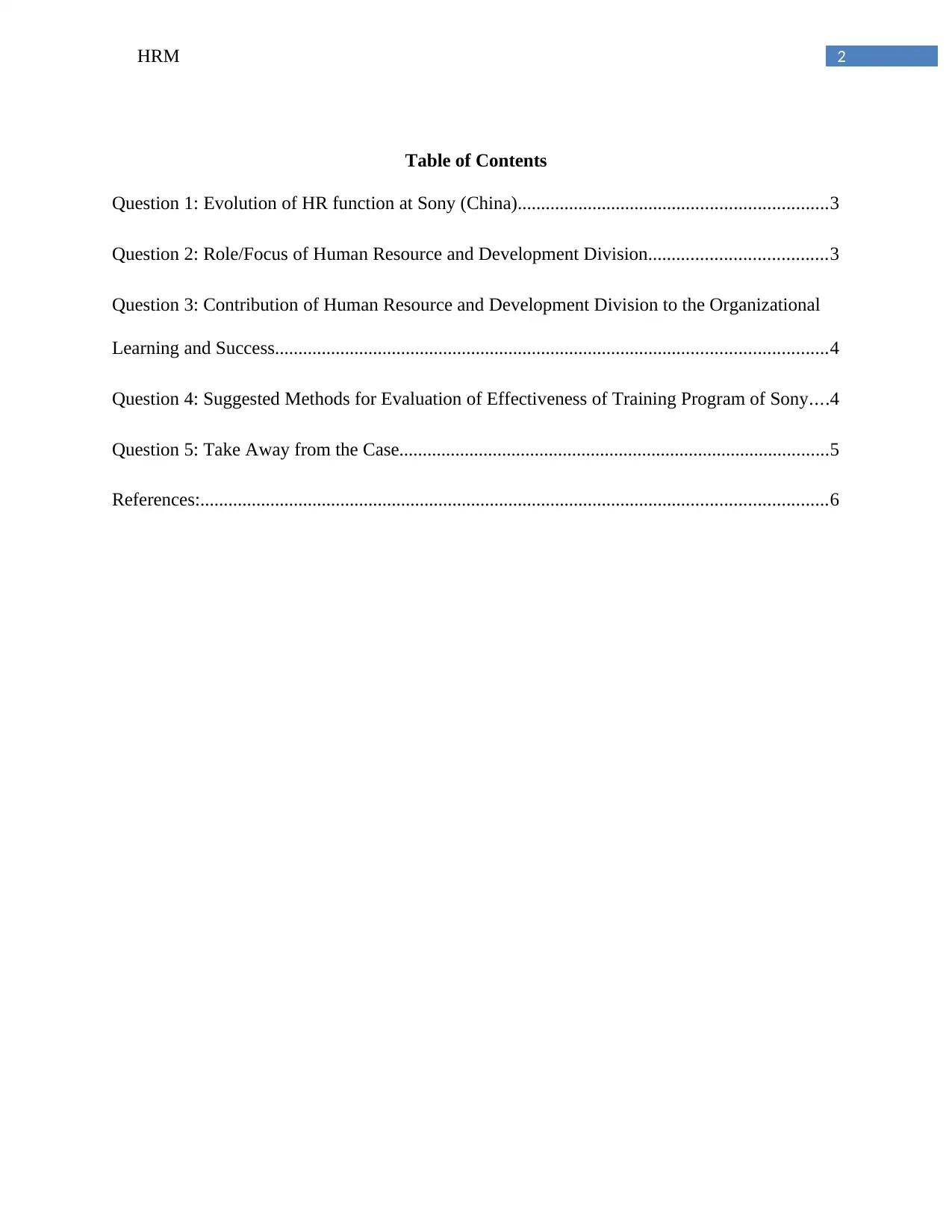
2HRM
Table of Contents
Question 1: Evolution of HR function at Sony (China)..................................................................3
Question 2: Role/Focus of Human Resource and Development Division......................................3
Question 3: Contribution of Human Resource and Development Division to the Organizational
Learning and Success......................................................................................................................4
Question 4: Suggested Methods for Evaluation of Effectiveness of Training Program of Sony....4
Question 5: Take Away from the Case............................................................................................5
References:......................................................................................................................................6
Table of Contents
Question 1: Evolution of HR function at Sony (China)..................................................................3
Question 2: Role/Focus of Human Resource and Development Division......................................3
Question 3: Contribution of Human Resource and Development Division to the Organizational
Learning and Success......................................................................................................................4
Question 4: Suggested Methods for Evaluation of Effectiveness of Training Program of Sony....4
Question 5: Take Away from the Case............................................................................................5
References:......................................................................................................................................6
⊘ This is a preview!⊘
Do you want full access?
Subscribe today to unlock all pages.

Trusted by 1+ million students worldwide
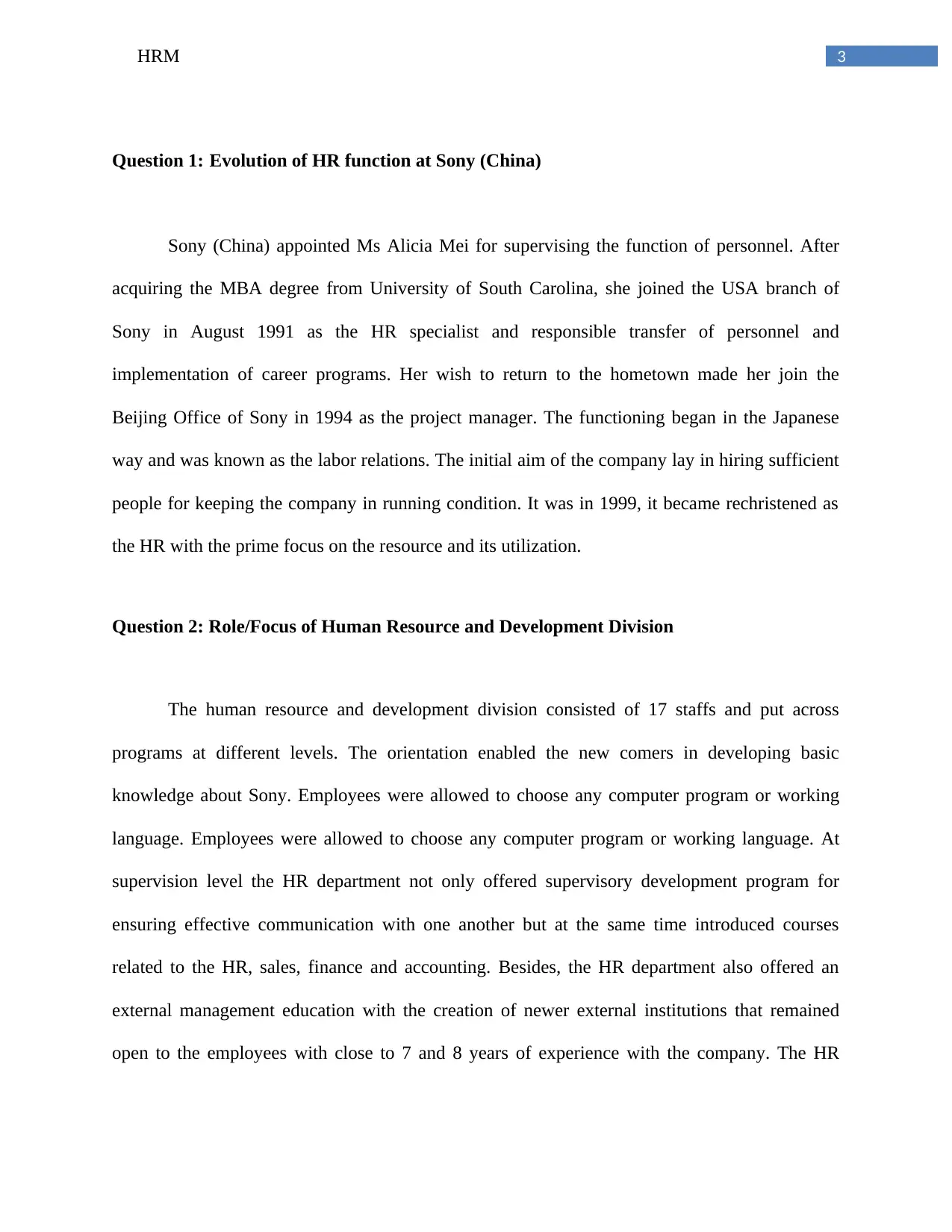
3HRM
Question 1: Evolution of HR function at Sony (China)
Sony (China) appointed Ms Alicia Mei for supervising the function of personnel. After
acquiring the MBA degree from University of South Carolina, she joined the USA branch of
Sony in August 1991 as the HR specialist and responsible transfer of personnel and
implementation of career programs. Her wish to return to the hometown made her join the
Beijing Office of Sony in 1994 as the project manager. The functioning began in the Japanese
way and was known as the labor relations. The initial aim of the company lay in hiring sufficient
people for keeping the company in running condition. It was in 1999, it became rechristened as
the HR with the prime focus on the resource and its utilization.
Question 2: Role/Focus of Human Resource and Development Division
The human resource and development division consisted of 17 staffs and put across
programs at different levels. The orientation enabled the new comers in developing basic
knowledge about Sony. Employees were allowed to choose any computer program or working
language. Employees were allowed to choose any computer program or working language. At
supervision level the HR department not only offered supervisory development program for
ensuring effective communication with one another but at the same time introduced courses
related to the HR, sales, finance and accounting. Besides, the HR department also offered an
external management education with the creation of newer external institutions that remained
open to the employees with close to 7 and 8 years of experience with the company. The HR
Question 1: Evolution of HR function at Sony (China)
Sony (China) appointed Ms Alicia Mei for supervising the function of personnel. After
acquiring the MBA degree from University of South Carolina, she joined the USA branch of
Sony in August 1991 as the HR specialist and responsible transfer of personnel and
implementation of career programs. Her wish to return to the hometown made her join the
Beijing Office of Sony in 1994 as the project manager. The functioning began in the Japanese
way and was known as the labor relations. The initial aim of the company lay in hiring sufficient
people for keeping the company in running condition. It was in 1999, it became rechristened as
the HR with the prime focus on the resource and its utilization.
Question 2: Role/Focus of Human Resource and Development Division
The human resource and development division consisted of 17 staffs and put across
programs at different levels. The orientation enabled the new comers in developing basic
knowledge about Sony. Employees were allowed to choose any computer program or working
language. Employees were allowed to choose any computer program or working language. At
supervision level the HR department not only offered supervisory development program for
ensuring effective communication with one another but at the same time introduced courses
related to the HR, sales, finance and accounting. Besides, the HR department also offered an
external management education with the creation of newer external institutions that remained
open to the employees with close to 7 and 8 years of experience with the company. The HR
Paraphrase This Document
Need a fresh take? Get an instant paraphrase of this document with our AI Paraphraser
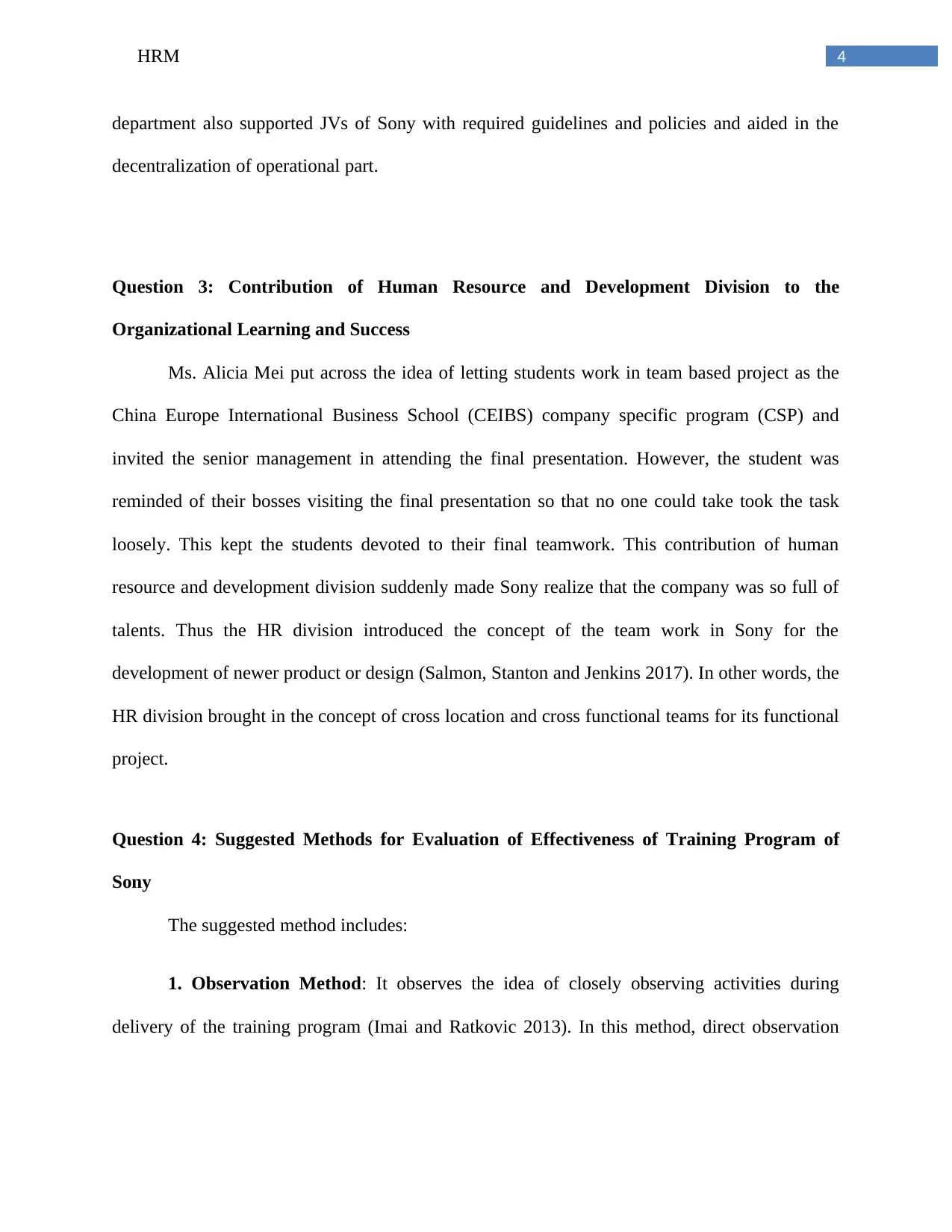
4HRM
department also supported JVs of Sony with required guidelines and policies and aided in the
decentralization of operational part.
Question 3: Contribution of Human Resource and Development Division to the
Organizational Learning and Success
Ms. Alicia Mei put across the idea of letting students work in team based project as the
China Europe International Business School (CEIBS) company specific program (CSP) and
invited the senior management in attending the final presentation. However, the student was
reminded of their bosses visiting the final presentation so that no one could take took the task
loosely. This kept the students devoted to their final teamwork. This contribution of human
resource and development division suddenly made Sony realize that the company was so full of
talents. Thus the HR division introduced the concept of the team work in Sony for the
development of newer product or design (Salmon, Stanton and Jenkins 2017). In other words, the
HR division brought in the concept of cross location and cross functional teams for its functional
project.
Question 4: Suggested Methods for Evaluation of Effectiveness of Training Program of
Sony
The suggested method includes:
1. Observation Method: It observes the idea of closely observing activities during
delivery of the training program (Imai and Ratkovic 2013). In this method, direct observation
department also supported JVs of Sony with required guidelines and policies and aided in the
decentralization of operational part.
Question 3: Contribution of Human Resource and Development Division to the
Organizational Learning and Success
Ms. Alicia Mei put across the idea of letting students work in team based project as the
China Europe International Business School (CEIBS) company specific program (CSP) and
invited the senior management in attending the final presentation. However, the student was
reminded of their bosses visiting the final presentation so that no one could take took the task
loosely. This kept the students devoted to their final teamwork. This contribution of human
resource and development division suddenly made Sony realize that the company was so full of
talents. Thus the HR division introduced the concept of the team work in Sony for the
development of newer product or design (Salmon, Stanton and Jenkins 2017). In other words, the
HR division brought in the concept of cross location and cross functional teams for its functional
project.
Question 4: Suggested Methods for Evaluation of Effectiveness of Training Program of
Sony
The suggested method includes:
1. Observation Method: It observes the idea of closely observing activities during
delivery of the training program (Imai and Ratkovic 2013). In this method, direct observation
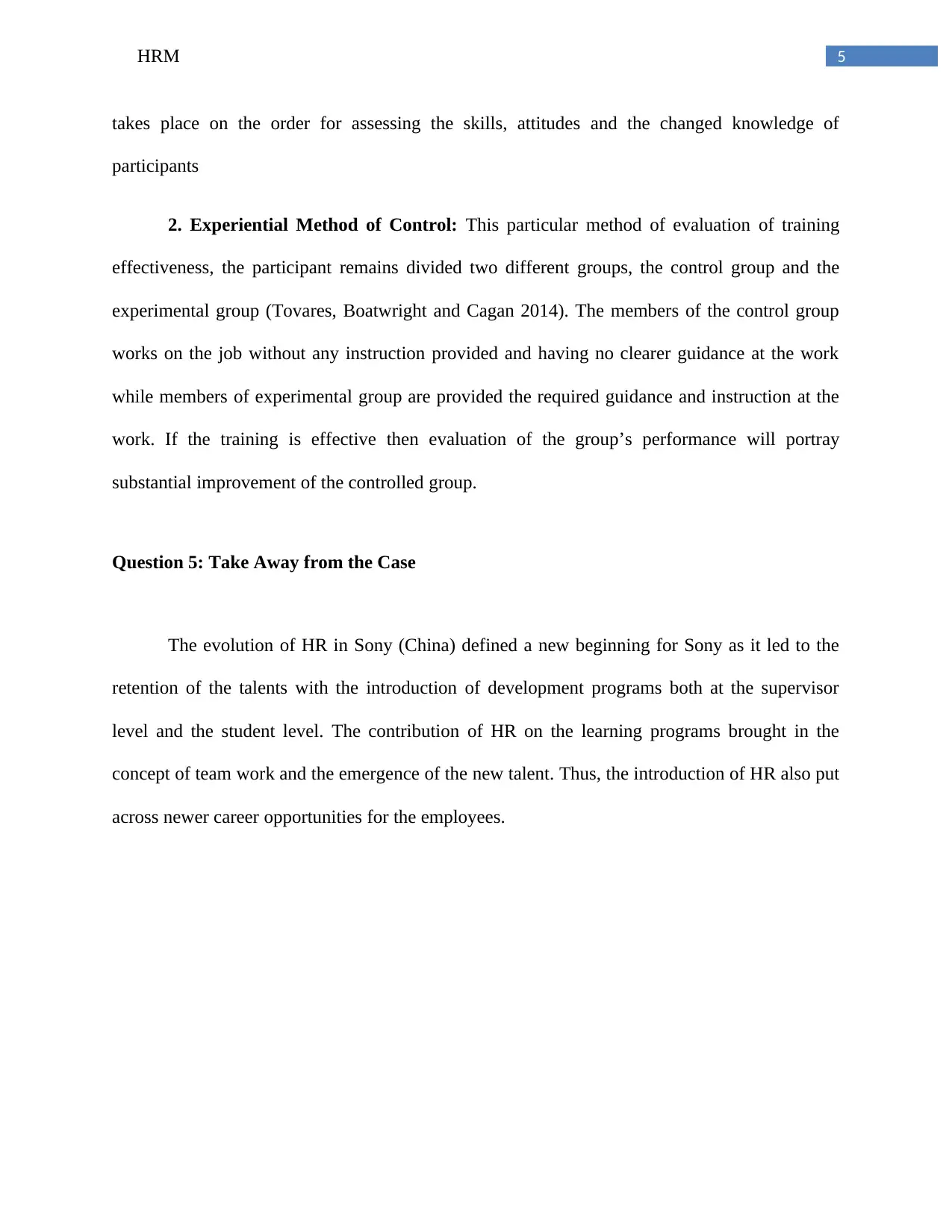
5HRM
takes place on the order for assessing the skills, attitudes and the changed knowledge of
participants
2. Experiential Method of Control: This particular method of evaluation of training
effectiveness, the participant remains divided two different groups, the control group and the
experimental group (Tovares, Boatwright and Cagan 2014). The members of the control group
works on the job without any instruction provided and having no clearer guidance at the work
while members of experimental group are provided the required guidance and instruction at the
work. If the training is effective then evaluation of the group’s performance will portray
substantial improvement of the controlled group.
Question 5: Take Away from the Case
The evolution of HR in Sony (China) defined a new beginning for Sony as it led to the
retention of the talents with the introduction of development programs both at the supervisor
level and the student level. The contribution of HR on the learning programs brought in the
concept of team work and the emergence of the new talent. Thus, the introduction of HR also put
across newer career opportunities for the employees.
takes place on the order for assessing the skills, attitudes and the changed knowledge of
participants
2. Experiential Method of Control: This particular method of evaluation of training
effectiveness, the participant remains divided two different groups, the control group and the
experimental group (Tovares, Boatwright and Cagan 2014). The members of the control group
works on the job without any instruction provided and having no clearer guidance at the work
while members of experimental group are provided the required guidance and instruction at the
work. If the training is effective then evaluation of the group’s performance will portray
substantial improvement of the controlled group.
Question 5: Take Away from the Case
The evolution of HR in Sony (China) defined a new beginning for Sony as it led to the
retention of the talents with the introduction of development programs both at the supervisor
level and the student level. The contribution of HR on the learning programs brought in the
concept of team work and the emergence of the new talent. Thus, the introduction of HR also put
across newer career opportunities for the employees.
⊘ This is a preview!⊘
Do you want full access?
Subscribe today to unlock all pages.

Trusted by 1+ million students worldwide
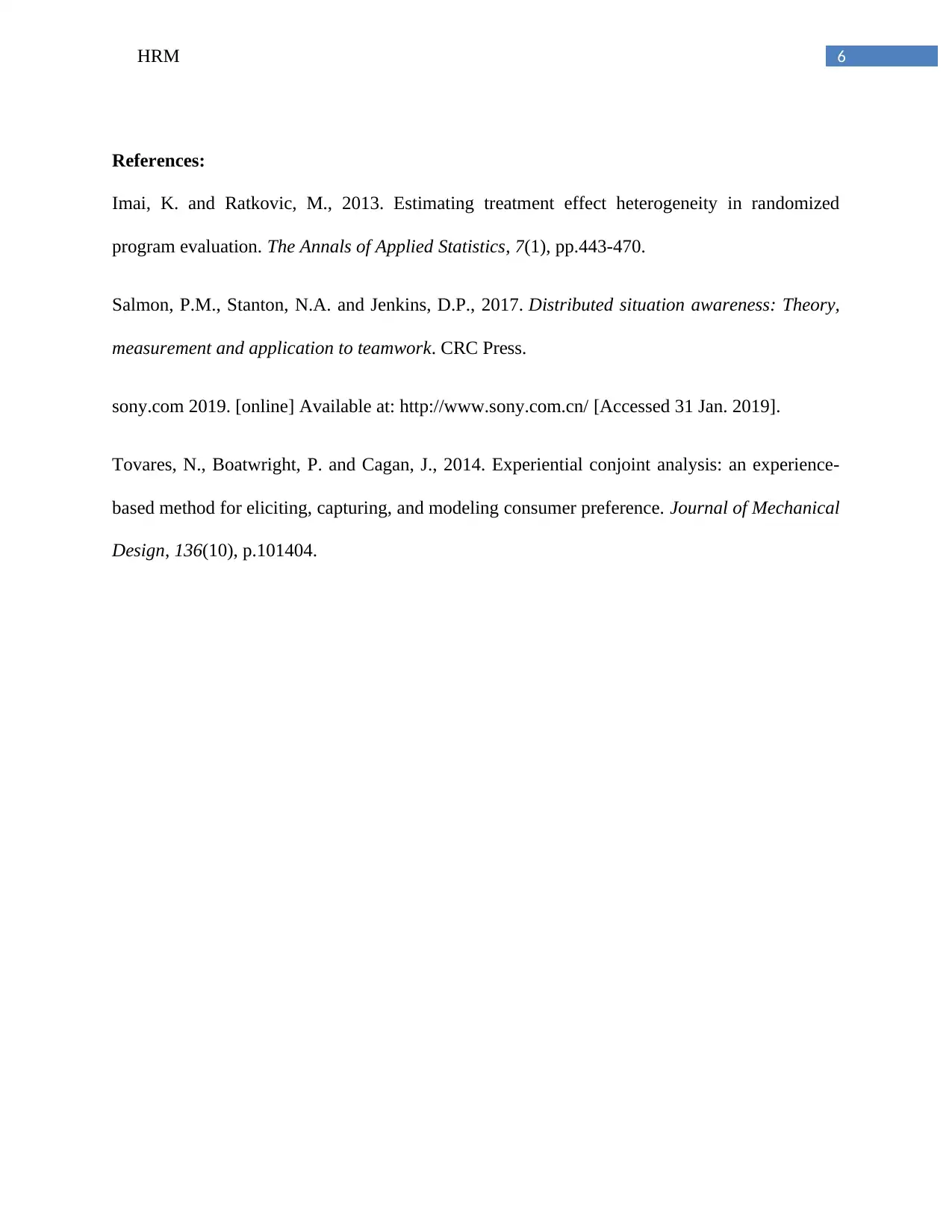
6HRM
References:
Imai, K. and Ratkovic, M., 2013. Estimating treatment effect heterogeneity in randomized
program evaluation. The Annals of Applied Statistics, 7(1), pp.443-470.
Salmon, P.M., Stanton, N.A. and Jenkins, D.P., 2017. Distributed situation awareness: Theory,
measurement and application to teamwork. CRC Press.
sony.com 2019. [online] Available at: http://www.sony.com.cn/ [Accessed 31 Jan. 2019].
Tovares, N., Boatwright, P. and Cagan, J., 2014. Experiential conjoint analysis: an experience-
based method for eliciting, capturing, and modeling consumer preference. Journal of Mechanical
Design, 136(10), p.101404.
References:
Imai, K. and Ratkovic, M., 2013. Estimating treatment effect heterogeneity in randomized
program evaluation. The Annals of Applied Statistics, 7(1), pp.443-470.
Salmon, P.M., Stanton, N.A. and Jenkins, D.P., 2017. Distributed situation awareness: Theory,
measurement and application to teamwork. CRC Press.
sony.com 2019. [online] Available at: http://www.sony.com.cn/ [Accessed 31 Jan. 2019].
Tovares, N., Boatwright, P. and Cagan, J., 2014. Experiential conjoint analysis: an experience-
based method for eliciting, capturing, and modeling consumer preference. Journal of Mechanical
Design, 136(10), p.101404.
1 out of 7
Related Documents
Your All-in-One AI-Powered Toolkit for Academic Success.
+13062052269
info@desklib.com
Available 24*7 on WhatsApp / Email
![[object Object]](/_next/static/media/star-bottom.7253800d.svg)
Unlock your academic potential
Copyright © 2020–2025 A2Z Services. All Rights Reserved. Developed and managed by ZUCOL.





